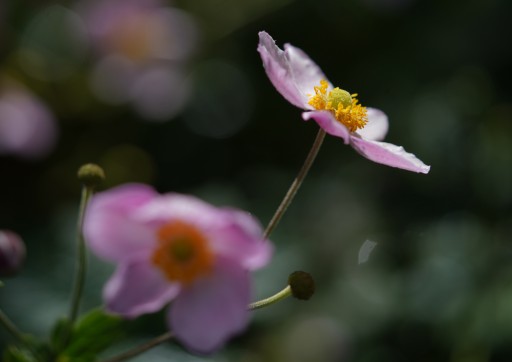We had rain followed by wind and clouds, with sun peeking though, so I took advantage to photograph my Japanese anemones, which look better than I had any right to expect them to, considering how the leaves were badly and completely chewed—just a mass of little black dots—throughout the summer.

Japanese anemones, with snakeroot in the background. 26sep22:14:07, sony A7c, sony 90mm macro, hazy light; f/2.8 ev-0.7, 1/1000s, ISO 50, WB: auto; scaled.
But eventually the bugs decided they were done, the plants put out new growth, and because I felt sorry for them, I watered them, even though I didn't expect much—that's why there's so much snakeroot, I've been letting this hardier native take over the bed. (And take over it does, though I enjoyed all the insects it attracts.)

Japanese anemones, with snakeroot in the background. 26sep22:14:08, sony A7c, sony 90mm macro, hazy light; f/2.8 ev-0.7, 1/650s, ISO 50, WB: auto; masking to brighten flowers, cropped and scaled in gimp.
This sort of hazy light is wonderful for flower photographers, though the variability was a bit frustrating; but without the cloud cover there's no way I could have got such softness at 2 in the afternoon. As a bonus, a hoverfly showed up in the last photo—these harmless creatures, despite looking like wasps, merely go about pollinating flowers.[1]

Japanese anemones, with snakeroot in the background. 26sep22:14:09, sony A7c, sony 90mm macro, hazy light; f/2.8 ev-0.7, 1/800s, ISO 50, WB: auto; brightened, cropped, scaled
[1]My understanding is that more flowers are pollinated by flies than bees, but bees tend to pollinate the commercially important ones, i.e. food plants.
Unless otherwise noted, text, image and objects depicted therein copyright 1996--present sylvus tarn.
Sylvus Tarn